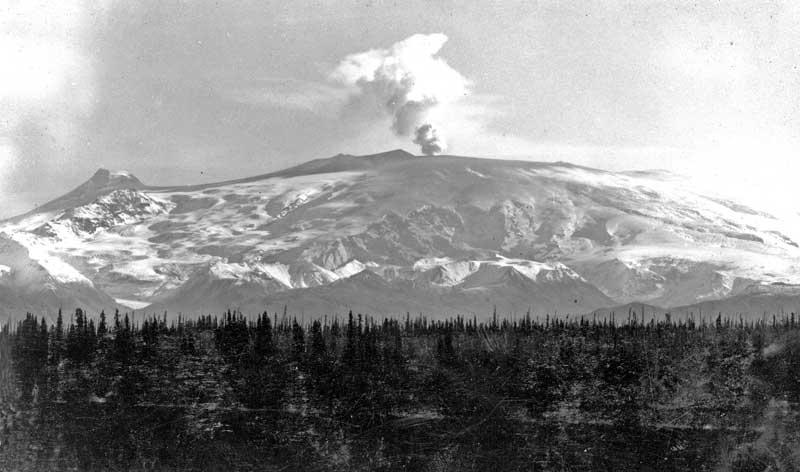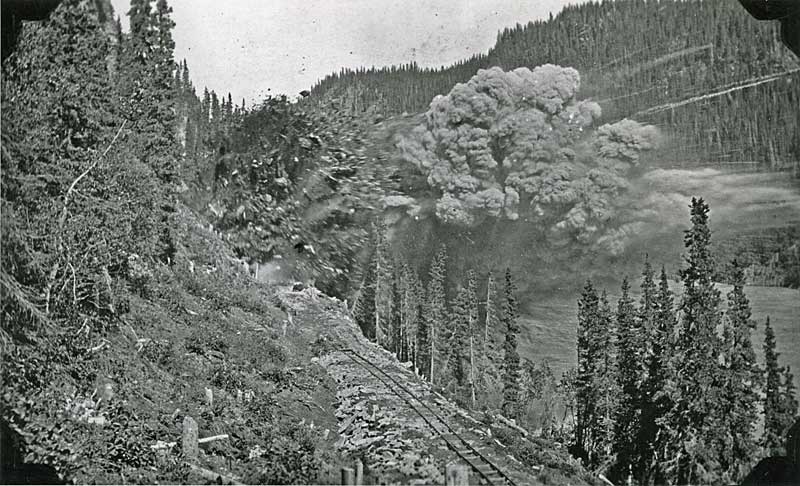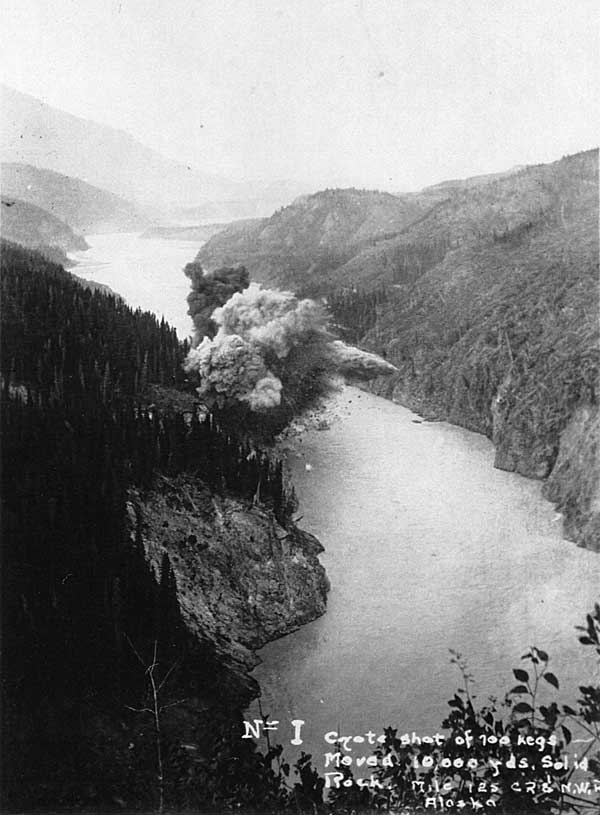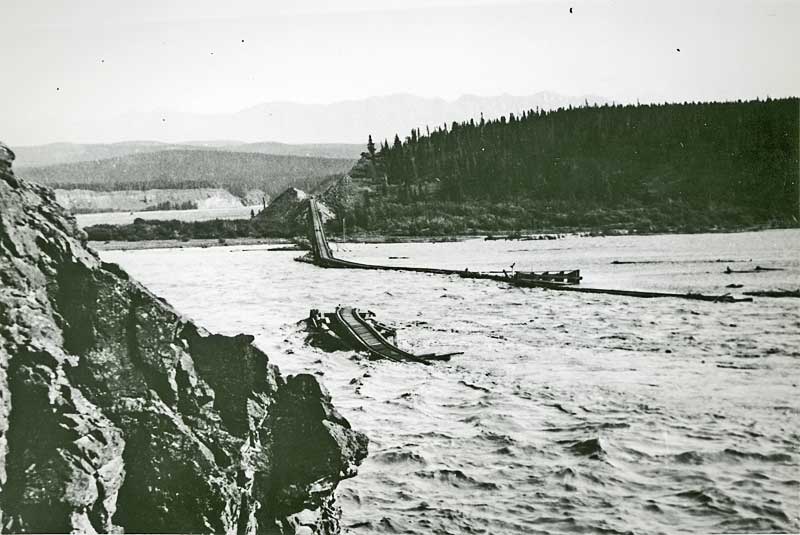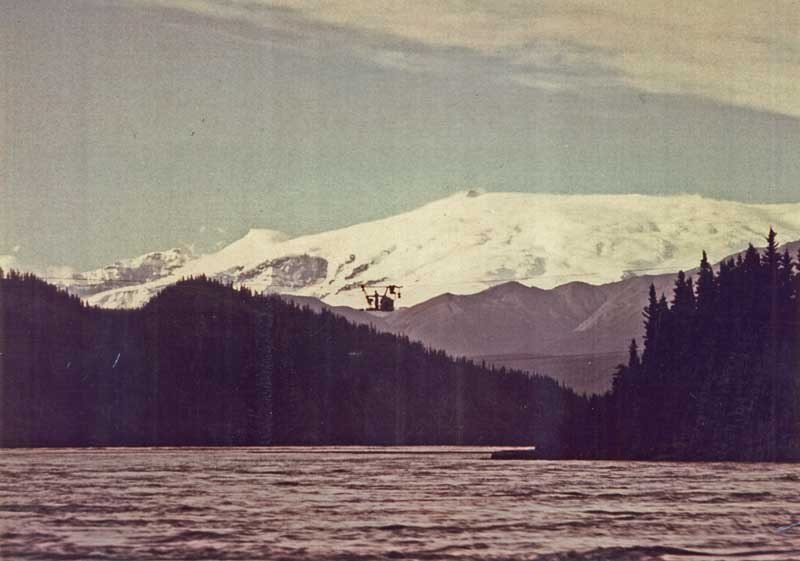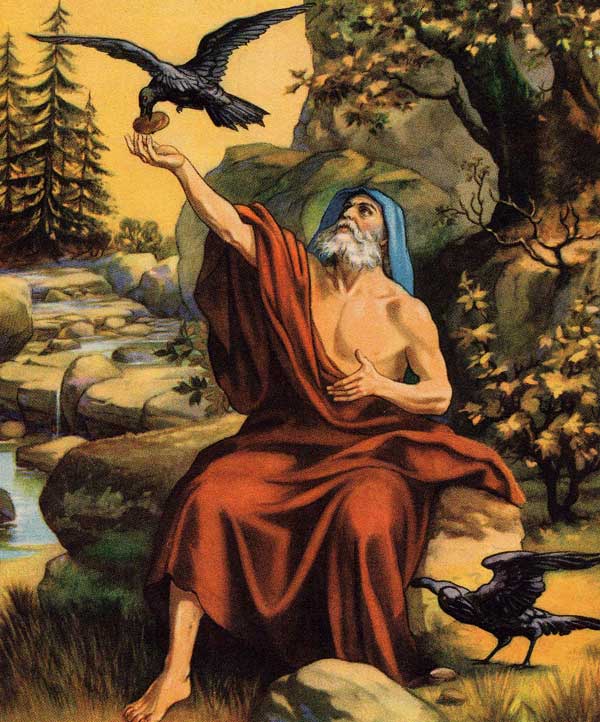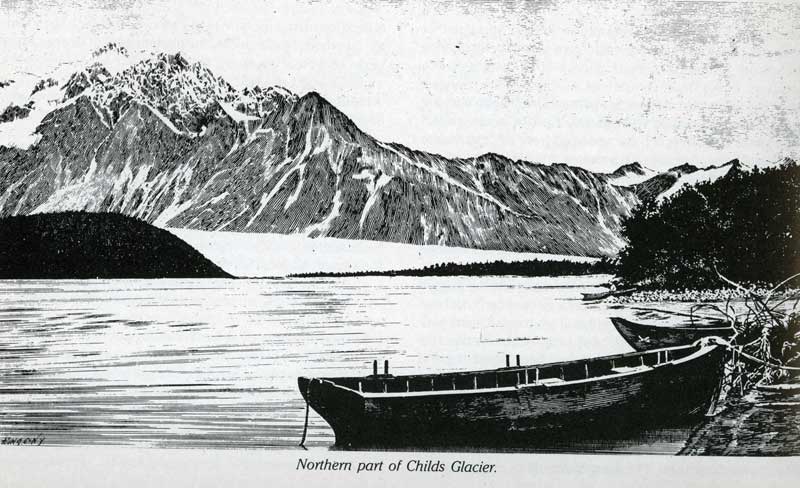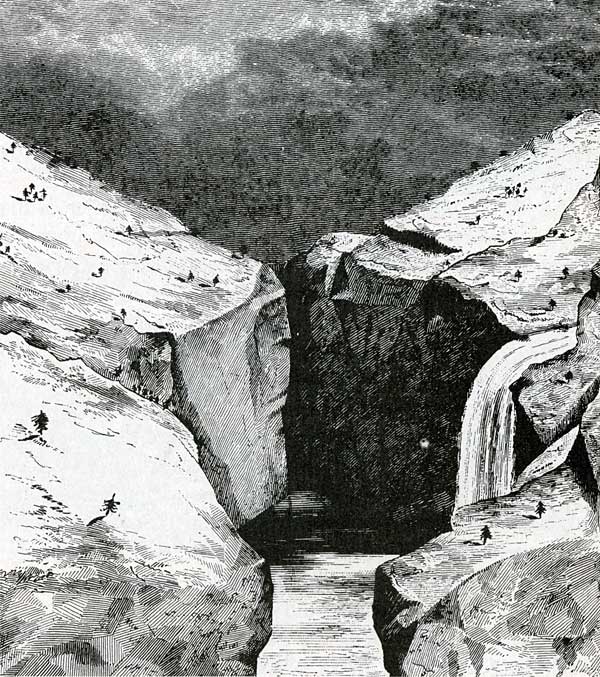Chapter 10: Abercrombie Rapids Landing, pt 2 |
The images below can be clicked for larger photo or drawing |
Chapters from the historic novel "Legacy of the Chief," by Ronald Simpson, and other items mostly related to the historic background of the Ahtnas in the context of Kennecott Copper & its Copper River & Northwestern Railway.
03 November 2010
Ch 10, Pt 2: "Abercrombie Rapids Landing"
Ch 10, Pt 1, "Abercrombie Rapids Landing"
Chapter 10: "Abercrombie Rapids Landing" |
All of the images below can be clicked for larger photo or drawing |
Ch 9, conclusion to "Nicolai's Raven Story of Creation"
Chapter 9: "Nicolai's Raven Story of Creation," pt 5-final page " No creature could have imagined the true violent nature of Creation as it was displayed in those days of the flooding and eruptions and earth shakings. The homes of almost all the creatures and the lives of many, including the young and the innocent, were lost because all had assumed that life would continue as it always had with no great changes. " What was even worse, few of the creatures knew of the existence or the power of the Great Creator. Of those who did, none thought to ask for His help until it was too late. " With the old world destroyed, flooded and broken up--and with the mountains still shaking and spewing fire and smoke and ashes angrily into the skies, choking the birds above as well as the creatures below, the head raven accompanied by many of his fellow birds finally flew up to Tall Peak to plead with the Great Creator. They wanted the disaster to at least stop spreading. | ||
| Early USGS photo of Mt. Wrangell, K'elt'aeni "the one who controls the weather", also "Uk'eledi "the one with smoke on it" |
" ' Why have you forgotten me?" asked the Great Creator. " ' I have given you complete rule over my creation long enough. Now you will teach my new creatures whom I will create out of all this destruction to learn how to live here. You will teach them everything that you know. Especially you will teach them the lesson that I am not to be ignored. " 'For I can become easily angered. I can always rearrange Creation again, as I have just done. You will talk to my new creatures, whom you will know as the Children of the Earth. It will be up to them to protect all of Creation--the lands and the great waters and the rivers, together with all my creatures which inhabit them. You will know that if you fail to teach them this important lesson they may destroy you.' " ' But if they destroy you, they will also destroy themselves. For this is the promise that I make to you now. The first of my children which will arrive here I will name the Raven Clan in your honor. For I love all my creatures including you who have forgotten me. It will fall to them to see that Creation is always protected from the foolishness of my other children. You will help them to understand that if they fail in this, I will once again be upset. And you do not want to see me upset again. The greatest lesson of all is this, that I will not be ignored nor forgotten. For I am always among you. If you remember who I am and ask of me what you require, I will provide it just as you ask. Never forget the lesson you have learned this day.' " |
Grandfather looked away from the flames, turning his attention to each
of us as the fire continued to burn even higher.
“I have not told you this story
just to pass the time. This is the story of your Raven Clan--the Saghani
utsuuy. That is who we are. We are the chosen ones.
“The white man has come to take his precious metals from the earth. He
cares nothing for this land--nor for us. He will take his precious
metals, upset the earth, and then he will leave. We have no use for his
treasures, nor for him. Nor should we. Soon we will have our land back
and be able to live in peace as before.
“You must never forget who you are, who your people are, or where you
came from. Even as you learn the new and strange ways of the white
man--and you must be a good student of him and his ways--you are one of
us, and you will always be one of us. Sometimes you will doubt yourself,
and it is important in those times that you remember what has happened
here tonight.”
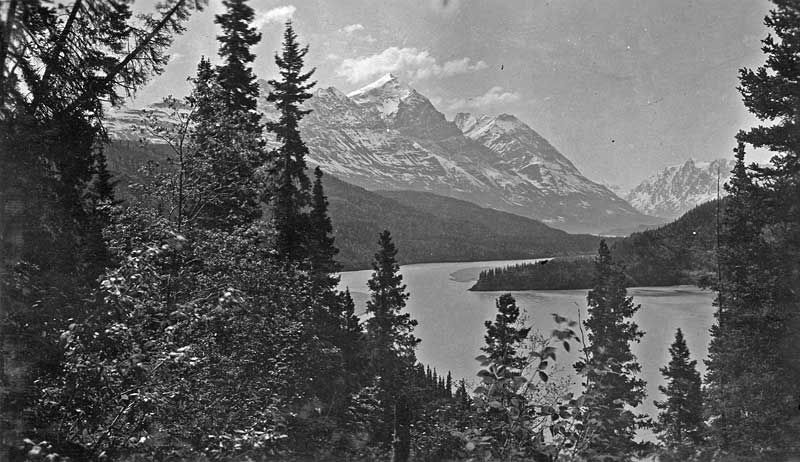 |
| Spirit Mountain south of Taral -USGS photo |
Nicolai had finished speaking. He looked up toward the shimmering,
brilliant Yay-kaas which were beginning to light up the entire sky with
a true dance of nature. He picked up the animal skin drum resting near
his side and began a loud rhythmic beat accompanied by his remarkably
clear and strong chanting voice as he broke into one of our ageless
spirit songs.
The three of us skeel’eh had danced many times to this particularly
lively song which reminded us of the old ways of generations of our
forefathers. It was a part of our potlatch ceremony--the gathering which
binds all Indians together as the true Children of the Earth.
As our voices joined with that of the old chief, the campfire
intensified. The old ghostly lodges around us--deserted for so many
seasons now--appeared to come to life with the spirits of the people of
our distant past. The sounds of many voices, long unheard and forgotten,
joined in with the chief in this last great song of an era passing into
history.
For Nicolai, the last great chief and shaman, spoke not just for our
people now living, but for all our Indian brothers--and for the spirits
of the people who had lived their lives and had died and been buried
here. These were the spirits Nicolai was preparing to join. Tonight we
could feel the true spiritual power of these, our ancestors. And we were
not afraid. For now we all felt the true power of what being an Ahtna
really meant.
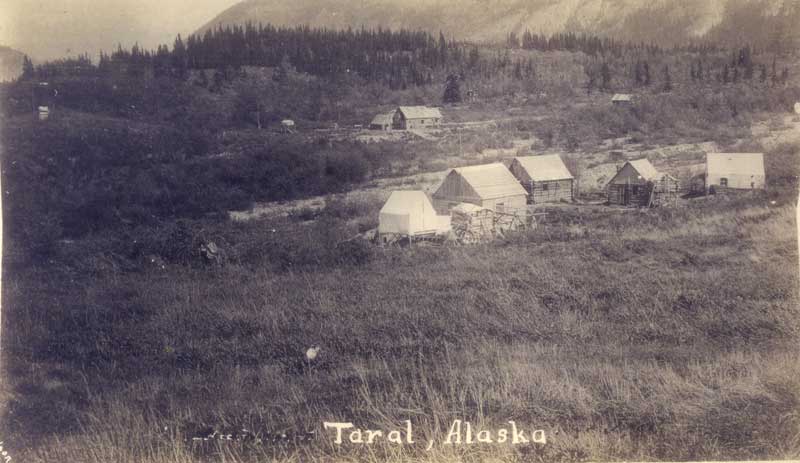 |
| Chief Skolai Nicolai's Taral --Candy Waugaman Collection |
Across the river at Eskilida’s camp the lone fire we had seen earlier
had gone out. The many lights near Chitina and Haley Creek camp also
dimmed until everything beyond Taral was completely dark except the
white-capped mountain tops which were illuminated by the light of the
cold, full moon.
The rest of the world had become insignificant under the night skies
highlighted by the spectacular dancing yay-koss, which in turn mirrored
our own dance on the ancient, traditional spirit grounds of Taral. Even
the roaring of the great river was muted by the intense sounds of the
chanting of three very young men singing with all their power, one great
elder of a dying generation pounding rhythmically and loudly on his
animal skin drum, and the spirits of a multitude of ancients--all
engaged in one delightful and intensely exciting dance of the spirits
from another time--a dance which would continue to reverberate up the
valleys of the Chitina and the Copper Rivers through the ages, echoing
forever the sounds of a people who would never leave the land in the
shadow of the Uk’eledi.
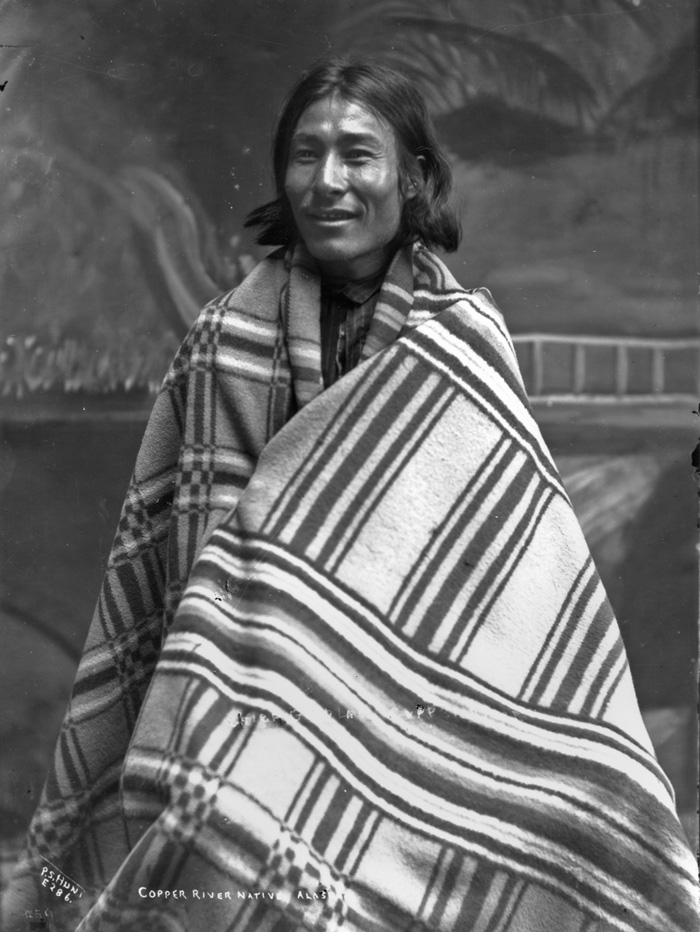 | ||
| Chief Goodlataw of Taral & Chittyna |
Continue with Chapter 10, "Abercrombie Rapids Landing"
Ch 9, Pt 4: "Nicolai's Raven Story of Creation"
Chapter 9, pt 4: "Nicolai's Raven Story of Creation" |
Michael and I quietly talked with each other while Charles drifted off to sleep. It was getting late for him, but we older brothers were very excited to be here. We speculated on the meaning of the story we had heard so far. We talked about going back to school and solemnly promised each other that we would both try to do well there. We resolved to do better than our white counterparts, because grandfather expected it of us. Finally Nicolai emerged from the lodge looking rested. He silently resumed his spot between Michael and me at the fire. We had both lost track of the time and had not been paying attention to the fire, so we had to work at resurrecting the flames. I reached over and nudged Charles awake because I did not want him to miss anything. Charles tried hard to fit in with us older boys and please us both. He seemed grateful to be woken up, smiling at me weakly but earnestly. Besides, I did not want the chief to catch any of us napping when he was telling us something he considered so important. The flames roared back up into a renewed level of energy. Grandfather was ready. He looked first at me, then at Charles, and finally at Michael. It was at this point that I thought how unthinkable it would be for anyone to sleep or otherwise fail to fully pay attention when Nicolai spoke. I felt relief that I had been able to wake up Charles before the old man noticed him sleeping. As was customary with Nicolai, he continued his story right where he had left off as if there had been no intervening time. He had an unnerving habit of carrying on his conversations days and even weeks afterward as if no time had passed since his last words were spoken. We had long since learned to pay careful attention to what the old chief was saying because no one wanted to offend him and risk becoming an object of his notoriously bad temper. Besides, it seemed clear enough to all of us in the family and clan that if Nicolai could remember everything he had said so clearly that he would continue the same conversation weeks later, it must be truly important. Until I met Stephen Birch some years later, I had never encountered anyone else who had this capacity to continue a conversation in that manner while expecting all parties to act as if no time had passed at all. Both also had a memory for names and faces which eluded the rest of us. Schee-ya resumed his tale of the ravens.
|
Chapter 9, Pt 3: Nicolai's Raven Story of Creation, |
Raven feeding Elijah |
| '" Events had forced some sort of change and the raven felt trapped. The winds which came from the angry Great Creator had helped to make the point. Things were clearly changing in a world that the ravens had assumed would always be the same. So the head raven, who was no fool, begged to be excused from the presence of the Creator so he could meet with the other birds. He called together all the bird creatures to discuss his meeting with the Great Spirit. |
| " ' I have looked at this problem, and this is like no other which we have faced. The Great Creator is bored and is looking for change. No matter what we say or do, he will make big changes which could destroy our whole way of life unless we change as well, exclaimed the head raven.' " ' I believe he is going to bring new creatures to our land which are much more like himself so he will not be so bored. He thinks that no creatures should have all the answers, even though we have all lived in the same world which has acted in the same way for as long as any of us can remember.' " ' These new creatures will probably not be very much like us, so we will have to learn to live with them--and teach them how to live with us.' " The head raven could see the same alarm which he had himself felt in the eyes of the other birds. He deemed it necessary to add these words: " ' So let us try to please the Great Spirit and do what he asks of us. If we must live with strange new creatures we certainly need more land, said the head owl. We know now that there is more land. No one seems to live there, so maybe we can use it. But we will need the help of the large creatures of the Great Waters if we are to move that land any closer to our own.' |
| " Now the head seagull spoke. " ' I believe I know who those large creatures are, for even though the young seagull who spotted them did not recognize them, I know them as the great whales. They sometimes journey close to our own land, but we have never made them welcome here, so they have mostly stayed out of sight to the south of us. Perhaps it is time to recognize that we my need them by inviting them to live closer to our own land.' |
| " ' What we need to do, ' suggested the head eagle, ' is ask the great whales to push the distant floating land toward us, so that it can become a part of our own island. We will need to tell them that in this way there will be enough land for everyone including the whales to gather and to hunt.' |
| " All this time the head raven was listening to this discussion among the birds and thinking to himself: " 'All these ages we ravens have been doing all the thinking for everyone. Now look what the Creator has done! Everyone is thinking for himself. Soon the birds will realize that we are really all equal. Our world is truly changing and I wish it was the way it was before.' |
| " But the raven kept his silence. He would only speak his concerns with his fellow ravens in the hope that the other birds would not realize how much the world had changed and how little control the ravens would now have over the new world. But he silently recognized what the Great Creator had done, and he kept his peace among the other creatures. He knew things would never be the same. |
| | |
" The other ravens were looking to the head raven for guidance. They all held similar thoughts, but no one wanted to admit what they feared out loud. Except among themselves the ravens would never speak of their fears to the other creatures. Not ever. Instead, the ravens decided among themselves that they would find a way to make the best of a world that they could only partly control. They would begin to learn how to survive in the land only the Great Creator could claim to possess all over again. |
| " Among the great bird gathering there was considerable excitement, for many of the birds knew to trust the judgment of the head seagull and the great owl and the head eagle because they seemed to have a plan that would work. It would be left to the head seagull to approach the whales and make the arrangements. |
| " So it would be. The great whales were only too happy to make their new home in the north. For the south was nice, but the whales liked the north better and had only been waiting for the opportunity to become a part of the land which for so long had been dominated by the ravens. |
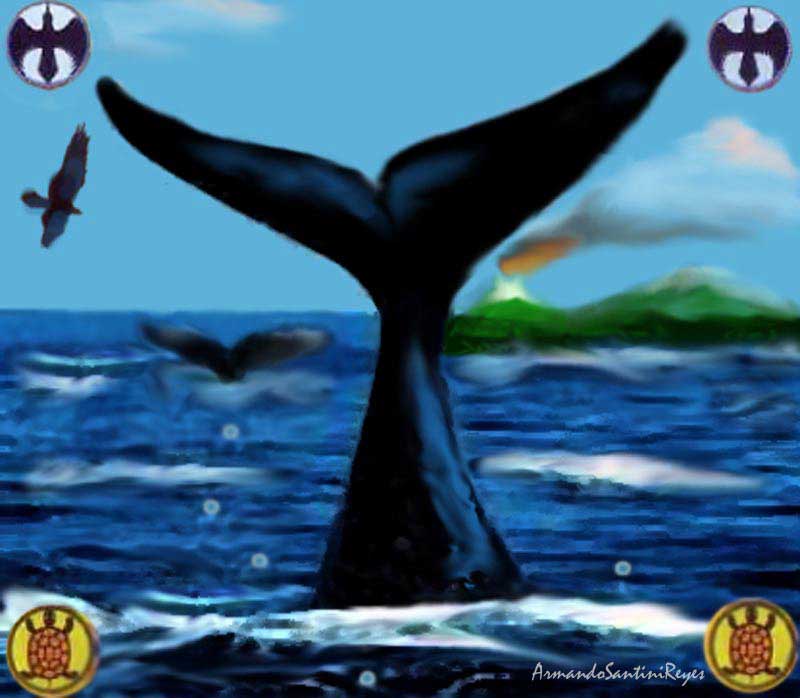 |
| " The whales decided among themselves not to tell the birds about the creatures which they knew inhabited the large floating island, for if the birds knew about the bears, the wolves, the foxes, the moose, and the others, they might change their minds. It was not, after all, the fault of the whales that the seagulls had not bothered to properly scout the island or that the birds had not sent any other scouting parties to better see what was there. |
| " Nor would the whales consult these same great creatures of the floating island who would soon have their home moved far to the north. For these land creatures had not made their peace with the whales either. The whales could see no reason to create an endless argument. |
| " So it was that on a day many ages ago the whales all got together and began pushing the large floating island in the south in the direction of the birds’ home well toward the far north. It was a great distance and it appeared that it would take a great amount of effort to move the island. Except that the whales discovered that once they gave the island a good push it continued heading north on its own. In fact once they got it moving, there was no way to stop it or control it, for the island was now on its way, as it was meant to be, under the watchful eye of the Great Creator. " |
Grandfather looked up at the dancing yaw-koss
overhead. He paused in his story. The weariness of all those years of
heavy responsibility was beginning to show. I realized at that moment
how valuable this time was that we were so privileged to share with
Nicolai. He had chosen the three of us young grandsons to listen to his
fable which told us so much about ourselves. He pulled the robe closely
around himself and stood up somewhat unsteadily.
“I must rest now. Enjoy the legacy which is yours on this night. For the
lights in the dark skies are dancing for you in a way which I have
seldom seen.”
The three of us had become so engrossed in the Raven Story that we had
not been paying any attention to what was happening around us. The yaw-koss
was moving in a dreamy floating motion in shimmering hues of red, green,
and white across the entire sky. Then a bright shooting star appeared
and quickly vanished in the direction of Spirit Mountain. It could
hardly be a coincidence. I looked at Michael, who returned a stare of
wonderment to me. Little brother Charlie was completely entranced, his
mouth dropping open as he viewed this natural fiery light display.
Nicolai quietly arose, turned around and vanished into the lodge behind
us. For the moment at least, the three of us skeel-eh were now alone to
contemplate the wonders which surrounded Nicolai. The constant roar of
the mighty Copper River was once again noticeable while at the same time
we could hear the gurgle of the nearby creek where we had cooled off
from our sezel. The light breeze from somewhere across the darkness in
the direction of the river seemed to carry with it hollow sound of a
distant train whistle.
This was the first steam train whistle we had ever
heard. It sounded more ghostly or spirit-like than real.
Spirit Mountain, with its fresh load of snow, stood out starkly in the
moonlight and appeared to give an evil stare in our direction. None of
us Natives ever ventures alone too close to this peak. We have a deep
rooted, superstitious fear of the mountain. I had never heard the story
behind the place, but it was in guarded whispers that we learned of evil
spirits which were said to continuously patrol the area. We would have
felt vulnerable at the spirit camp of Taral except for the reassuring
presence of Nicolai, who we believed had strong contacts in the
spiritual realm.
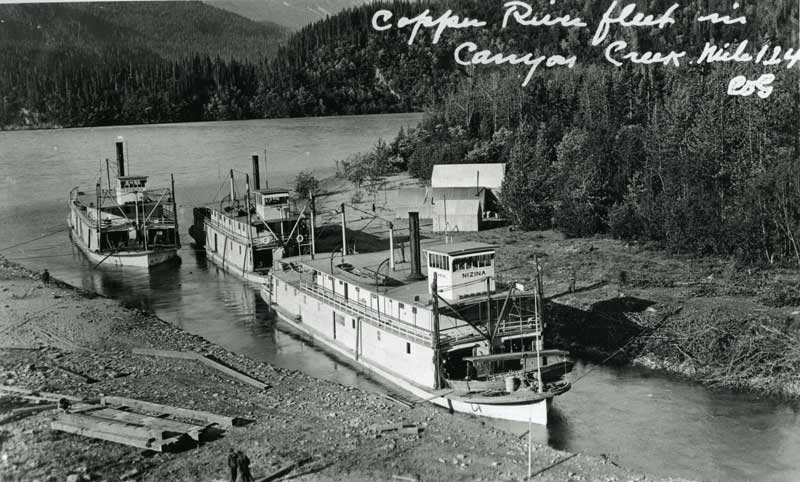 |
| The three construction-era steamers parked at "Canyon Creek," CRNW mile 124, now known as "Haley Creek." This is just downriver from Taral and on the west bank. This was the location of one of the construction camps at the time this story was being told. From here a steam whistle blast possibly could have been heard in Taral. --UAF, Copper River RR SE Alaska 99-290-11 |
Subscribe to:
Comments (Atom)







